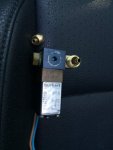- 1,579
- 556
- 113
- Location
- Greenback, TN
Here are some notes on the engine cooling, fan system components.
The temperature switch is located on the coolant piping in front of the engine. This is a switch, not a sensor, and has two wires. It is a Kysor 07950, 200 deg, NC-normally closed when cold (reads zero resistance), two wire. In operation, the switch will be closed unless the coolant temperature goes above 200 deg F, then the switch opens. Check the resistance with an Ohmmeter for near zero Ohms.
So does it open above 200 deg? The switch can easily be tested. Borrow a pan of water, set on the stove, insert the switch, and boil the water. The switch should open about the time the water boils.
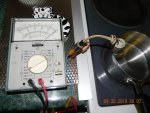
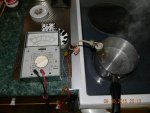
Yeah, I still prefer an analog meter. The needle to the right is switch closed, to the left, open, with water boiling.
This switch was working.
With the switch closed, 24v DC is applied to the fan solenoid valve (behind the passenger kick plate), and air pressure is applied to the fan clutch. The fan is driven only by the viscous coupling unless the coolant is over 200 deg.
This is the fan solenoid valve: Take off the kick plate and the solenoid is hanging in the upper right side, easily reached from a stool/stump/concrete block on the ground.
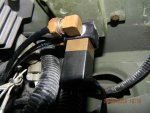
The easiest-to-reach tube is the supply of air. The hard to reach tube is the tube to the fan clutch. Remember, there is power to the solenoid under normal operating conditions (less than 200 deg). There is air to the fan, unlocking it's clutch. With engine off, the fan can be turned by hand, feeling the viscous coupling. Remember, there has to be air on the system for this to work.
Find the wire from the solenoid, mark the socket it came from (number 34 on mine), and unplug it. This removes 24v from the solenoid and the fan solenoid should dump, and fan clutch should connect and run under power with engine on.
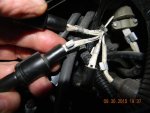
The air dump can be tested with engine off. The fan will not turn by hand after air is dumped. This explains a discrepancy in some of the threads: will the fan turn or not? It will turn if there is air on the system. The fan will not turn if there is no air because the clutch is locked.
It's fairly obvious if the temperature switch is not closed while cool. Replace it.
So what if the solenoid does not work, and this is apparently a common problem. The solenoid can be removed in two ways, either complete assembly (which I preferred), or taken apart where it was mounted. I did it both ways as seen in the pictures.
Four bolts can be removed and the mounting bracket comes out. One bolt is hard to get to (!!) and I did not replace it. There is no clearance underneath the tubing fitting to the fan air hose (left rear as you look at it).
Then unscrew the two hoses and unseat them from the fitting. There will be air loss. Best to bleed the air system first.
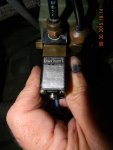
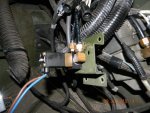
The solenoid can be tested with a 24 volt source. I used a 24v radio battery. Make and break the connection to the connector of the solenoid. If your solenoid is like mine, it will not cycle. Have to take it apart. If it does cycle the result is really subtle. Some people report unsticking their solenoid with application of oil.
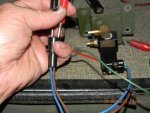
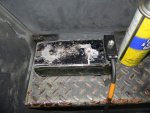
There are four screws through the rear of the solenoid coil assembly, the black rectangle. Two of those have no glyptol/point in the slot. Unscrew those. The solenoid will be free of the base where the tubing fittings are located. There are seals in between so work in a good spot to catch loose items.
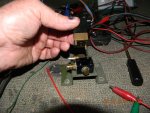
Remove the remaining 2 screws, the ones with glyptol. The solenoid comes apart and there are small parts and o-rings and the valve seat and seal.
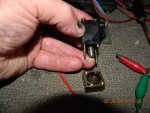
There is access to the valve solenoid slug with the seal in the end. The slug was sticking. I lubricated it then reassembled.
With the solenoid reinstalled but not plugged in, applying 24v to the solenoid would cycle the fan on and off.
When plugging in the solenoid, notice there are two available sockets! Hope you marked the right one to use.
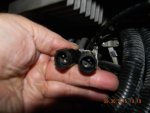
But, if you didn't, you can start the engine and measure the voltage between the contacts in both those sockets. One will have 24v on it. That's the one to plug in. There is 24v on this one coming through the temp switch.
Once it's all back together you can test your work by unplugging that connector again. The fan should turn on.
The temperature switch is located on the coolant piping in front of the engine. This is a switch, not a sensor, and has two wires. It is a Kysor 07950, 200 deg, NC-normally closed when cold (reads zero resistance), two wire. In operation, the switch will be closed unless the coolant temperature goes above 200 deg F, then the switch opens. Check the resistance with an Ohmmeter for near zero Ohms.
So does it open above 200 deg? The switch can easily be tested. Borrow a pan of water, set on the stove, insert the switch, and boil the water. The switch should open about the time the water boils.


Yeah, I still prefer an analog meter. The needle to the right is switch closed, to the left, open, with water boiling.
This switch was working.
With the switch closed, 24v DC is applied to the fan solenoid valve (behind the passenger kick plate), and air pressure is applied to the fan clutch. The fan is driven only by the viscous coupling unless the coolant is over 200 deg.
This is the fan solenoid valve: Take off the kick plate and the solenoid is hanging in the upper right side, easily reached from a stool/stump/concrete block on the ground.

The easiest-to-reach tube is the supply of air. The hard to reach tube is the tube to the fan clutch. Remember, there is power to the solenoid under normal operating conditions (less than 200 deg). There is air to the fan, unlocking it's clutch. With engine off, the fan can be turned by hand, feeling the viscous coupling. Remember, there has to be air on the system for this to work.
Find the wire from the solenoid, mark the socket it came from (number 34 on mine), and unplug it. This removes 24v from the solenoid and the fan solenoid should dump, and fan clutch should connect and run under power with engine on.

The air dump can be tested with engine off. The fan will not turn by hand after air is dumped. This explains a discrepancy in some of the threads: will the fan turn or not? It will turn if there is air on the system. The fan will not turn if there is no air because the clutch is locked.
It's fairly obvious if the temperature switch is not closed while cool. Replace it.
So what if the solenoid does not work, and this is apparently a common problem. The solenoid can be removed in two ways, either complete assembly (which I preferred), or taken apart where it was mounted. I did it both ways as seen in the pictures.
Four bolts can be removed and the mounting bracket comes out. One bolt is hard to get to (!!) and I did not replace it. There is no clearance underneath the tubing fitting to the fan air hose (left rear as you look at it).
Then unscrew the two hoses and unseat them from the fitting. There will be air loss. Best to bleed the air system first.


The solenoid can be tested with a 24 volt source. I used a 24v radio battery. Make and break the connection to the connector of the solenoid. If your solenoid is like mine, it will not cycle. Have to take it apart. If it does cycle the result is really subtle. Some people report unsticking their solenoid with application of oil.


There are four screws through the rear of the solenoid coil assembly, the black rectangle. Two of those have no glyptol/point in the slot. Unscrew those. The solenoid will be free of the base where the tubing fittings are located. There are seals in between so work in a good spot to catch loose items.

Remove the remaining 2 screws, the ones with glyptol. The solenoid comes apart and there are small parts and o-rings and the valve seat and seal.

There is access to the valve solenoid slug with the seal in the end. The slug was sticking. I lubricated it then reassembled.
With the solenoid reinstalled but not plugged in, applying 24v to the solenoid would cycle the fan on and off.
When plugging in the solenoid, notice there are two available sockets! Hope you marked the right one to use.

But, if you didn't, you can start the engine and measure the voltage between the contacts in both those sockets. One will have 24v on it. That's the one to plug in. There is 24v on this one coming through the temp switch.
Once it's all back together you can test your work by unplugging that connector again. The fan should turn on.
Last edited:





